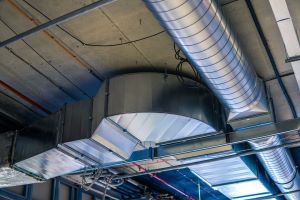Sheet metal for HVAC ductwork is a popular product for professional metal fabricators, as it is always in demand. New buildings require new HVAC systems and older buildings may need new systems when the old ones fail, so specializing in sheet metal production for HVAC systems can certainly be a productive business option.
Understanding the Significance of Sheet Metal in HVAC Ductwork
In the intricate world of HVAC systems, the choice of materials plays a pivotal role. Sheet metal, in particular, stands out for its significance in crafting efficient and durable HVAC ductwork. Typically, there are two types of metal sheeting used in HVAC ductwork: galvanized mild steel and aluminum.
Galvanized Mild Steel
When steel has been galvanized, it has been coated with zinc to prevent corrosion and rusting, helping to maximize its lifespan in a ductwork system. Furthermore, mild steel is pliable and can be fabricated into nearly any shape with relative ease. This makes it particularly useful for uncommon HVAC system designs and specific installation requirements. Once the mild steel sheets are fabricated, they are typically wrapped in an insulating material to enhance performance.
Aluminum
Like mild steel, aluminum is versatile and can be easily shaped into sheets for HVAC applications. Compared to steel, however, aluminum is lightweight, making it much easier to install. During installation, aluminum panels are attached using aluminum tape and glue.
How Does Galvanized Mild Steel Differ From Aluminum in HVAC Applications?
For HVAC applications, the choice between galvanized mild steel and aluminum is crucial. Galvanized mild steel, known for its robustness, contrasts with the lightweight and corrosion-resistant nature of aluminum. While galvanized mild steel ensures durability and is often preferred for its strength, aluminum stands out for its versatility and suitability in corrosive environments. Understanding the distinct characteristics of each material is crucial in determining the most suitable option for specific HVAC applications.
What Are the Advantages of Using Galvanized Mild Steel in HVAC Systems?
Galvanized mild steel is an excellent choice for HVAC systems, as it offers a range of advantages. Its inherent strength and resistance to corrosion make it an ideal choice for ductwork. Additionally, galvanized mild steel is cost-effective, providing both durability and affordability—a combination that significantly contributes to the longevity and efficiency of HVAC systems.
What Are the Benefits of Using Aluminum in HVAC Ductwork?
Aluminum’s rise in popularity for HVAC ductwork is attributed to its unique benefits. The lightweight nature of aluminum makes it easier to handle and install, reducing overall project costs. Furthermore, aluminum’s corrosion resistance ensures longevity, making it a valuable choice for environments prone to moisture or harsh conditions. Therefore, aluminum not only meets but exceeds the demands of modern HVAC applications.
What Fabrication Techniques Are Commonly Used for Steel & Aluminum in HVAC Systems?
For both steel and aluminum, common fabrication techniques include welding, forming, and cutting. Welding ensures the seamless integration of components, forming allows for the creation of complex shapes, and cutting ensures precision in tailoring materials to exact specifications.
Advantages of CNC Plasma Cutting Machines in Fabricating Mild Steel or Aluminum for HVAC Ductwork
Because steel and aluminum are both conductive metals, professional fabricators often use CNC plasma cutting machines to process these materials. This has emerged as a game-changer, as these advanced cutting machines bring a host of advantages, revolutionizing the precision and efficiency of the fabrication process. They offer:
- Precision and accuracy – CNC plasma cutting machines excel in providing unparalleled precision, ensuring that each cut is executed with microscopic accuracy. This precision is crucial in the fabrication of HVAC ductwork, where even the slightest deviation can impact system performance.
- Versatility in material handling – Whether working with mild steel or aluminum, CNC plasma cutting machines offer remarkable versatility. They adeptly handle various thicknesses and specifications, offering flexibility in material selection without compromising on precision.
- Speed and efficiency – Time is of the essence in HVAC projects, and CNC plasma cutting machines deliver on the need for speed. The automated and high-speed cutting capabilities of these machines significantly reduce production times, allowing for quicker turnaround on fabrication projects.
- Complex design capabilities – HVAC ductwork often demands intricate designs to maximize efficiency. CNC plasma cutting machines excel in translating complex designs into reality, enabling the creation of precisely shaped components that enhance the overall performance of the HVAC system.
- Cost-effectiveness – While precision and efficiency are paramount, CNC plasma cutting machines also provide cost-effectiveness by minimizing material wastage. The ability to optimize cutting paths and reduce errors translates into savings, making these machines an economically viable choice for HVAC ductwork fabrication.
Meeting Your HVAC Ductwork Fabrication Needs
Machitech is a leading manufacturer of heavy-duty CNC plasma cutting tables that can help improve the quality of sheet metal production. Plus, our solutions include free and unlimited support for life. Contact Machitech today to learn how we can simplify the HVAC ductwork fabrication process for your company.
 English
English  Français
Français 
